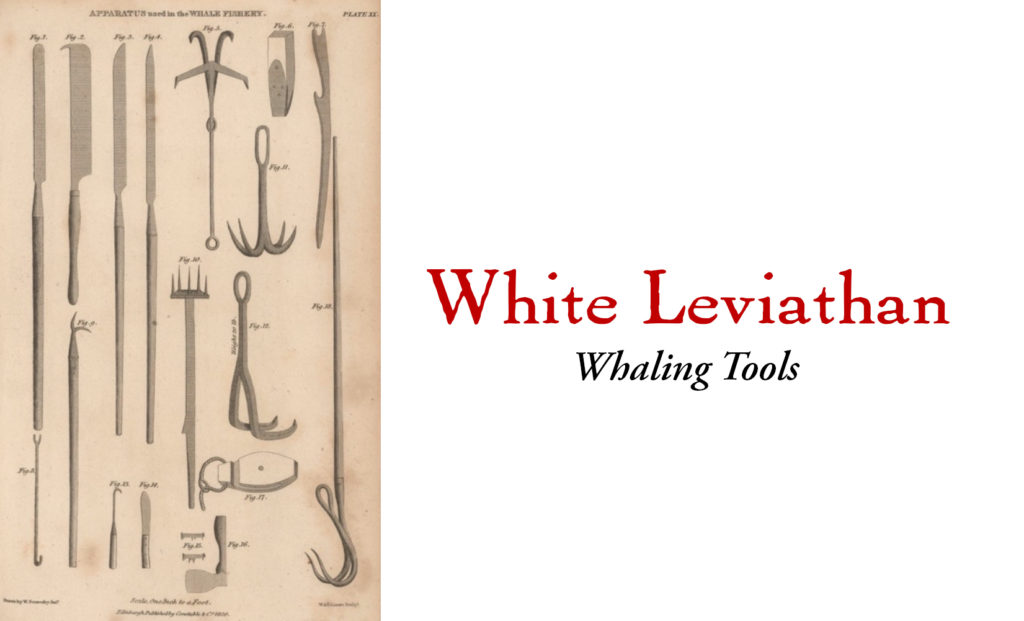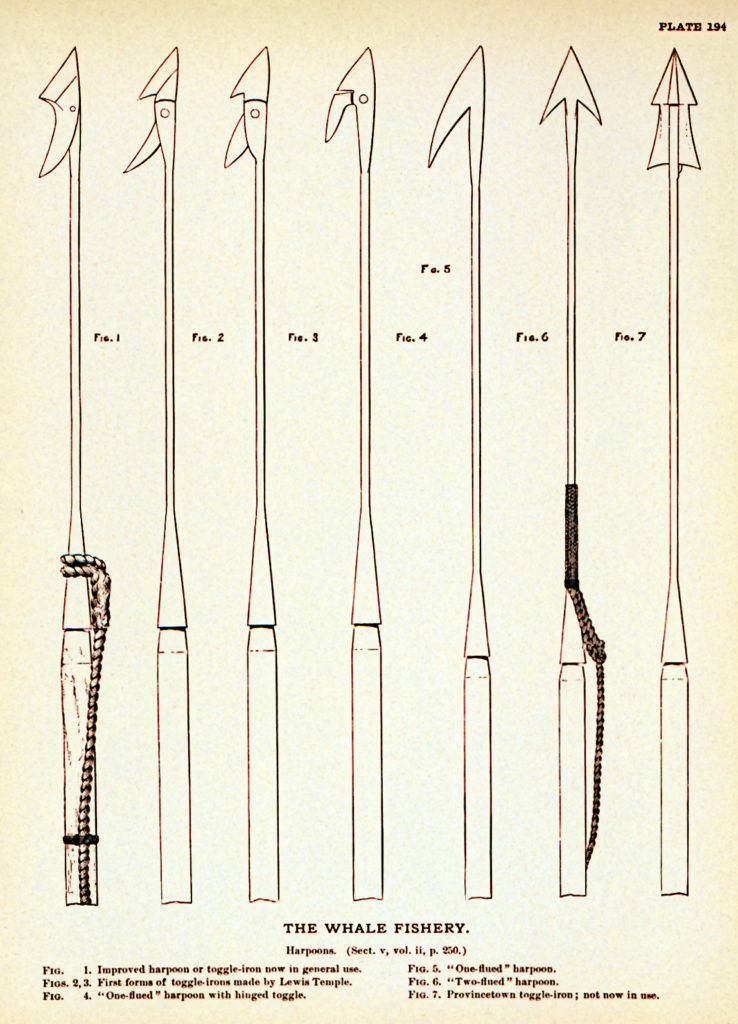Whaling Tools
- At September 17, 2021
- By Great Quail
- In Call of Cthulhu
 0
0
Tools of the Trade
It requires dozens of specialized tools to hunt, butcher, and render a whale. This section lists some of the more important, with notes on using them as improvised mêlée weapons. There’s also the usual accruements of a sailing ship, many of which can be swept up on a moment of passion an incorporated into brawl; including the chisels, awls, and mallets in a caulking set, various rigging tools, belaying pins, and grapnels, galley utensils, the anchor spoon, longshoreman hooks and chine hooks, axes and hatchets, and the blacksmith tools.
Whaling Tools
| Name | Skill | Damage |
| Blubber Fork | Fighting (Brawl) | 1D6+2+DB |
| Blubber Gaff | Fighting (Brawl) | 1D4+DB |
| Blubber Knife | Fighting (Brawl) | 1D4+1+DB |
| Blubber Pike | Fighting (Brawl) | 1D8+DB |
| Boarding Knife | Fighting (Brawl) | 1D8+DB |
| Boat Spade | Fighting (Brawl) | 1D6+DB |
| Bone Spade | Fighting (Brawl) | 1D6+1+DB |
| Hand-Lance | Fighting (Lance) | 1D8+1+DB |
| Harpoon: One-Flued | Fighting (Harpoon) | 1D10+DB |
| Harpoon: Two-Flued | Fighting (Harpoon) | 1D10+1+DB |
| Harpoon: Toggle Gig | Fighting (Harpoon) | 2D6+1+DB |
| Head Spade | Fighting (Brawl) | 1D6+1+DB |
| Gouge Spade | Fighting (Brawl) | 1D4+1+DB |
| Mincing Knife | Fighting (Brawl) | 1D6+DB |
The tools are described in detail below, listed in order of their general shipboard location.
Whaleboat Tools
The following tools are part of a whaleboat’s standard equipment, and are used offensively to hunt, slaughter, and claim a whale. The proper use of harpoons and lances is covered under “Hunting Whales.”
Harpoon
The whaleman’s iconic tool, a harpoon is a spear made by fixing a three-foot long “harping iron” onto a six-foot wooden pole. The function of the harpoon is not to kill the whale, but to attach the whaleline—a 900-foot length of rope connecting the quarry to the whaleboat. In this way, it’s more of a glorified fishing hook than a lethal weapon; that role is placed by the mate’s lance. Most harpoons use a pole made from oak or hickory, the bark retained to afford a better grip. The base of the harping iron—usually just called the “iron”—flares into a socket, which fits over the pole at the “joint.” The whaleline is spliced around this joint, then stretched and “stopped” to the pole, trailing away through an eye-splice halfway down the pole. On most harpoons, the iron is marked with the ship’s name or initials.
The business end of the harpoon sports a wicked barb designed to fasten itself in the flesh of the Leviathan. It’s here where one sees the most variation in harpoons, and blacksmiths are always tinkering with different types of barbs. Traditional harpoons are made from wrought iron, and terminate in one or two “flues.” More sophisticated harpoons are tipped by a “toggle,” a hinged flue that swings open inside the whale’s flesh. More expensive but stronger than traditional harpoons, toggles take longer to craft. In 1848 a New Bedford blacksmith named Lewis Temple invented a particularly effective toggle. Known as the “porpoise iron” or “Temple’s gig,” this harpoon eventually dominated the whaling trade, rendering traditional harpoons obsolete.
| The Morgan Gig For the “porpoises” (groan) of White Leviathan, Lewis Temple’s invention has been pre-empted by Leland Chappell Morgan, the Quiddity’s blacksmith, who introduced his “Morgan’s gig” to the whale fishery in the early 1840s. |
Tossing the Iron
Darting a harpoon is a difficult task. The harpoon itself is heavy, and the attached whaleline makes it even more cumbersome, especially if the hemp is wet. Harpooneers prefer to thrust the iron directly into the whale; but that’s not always possible. Even more challenging, a harpoon must be thrown from the bow of a pitching whaleboat! For all practical purposes, the effective range of a flung harpoon is only 10 feet. The Keeper may double or triple this range with Hard or Extreme successes. A character lacking the Fighting (Harpoon) skill may dart a harpoon with a Throw roll, but suffers a –1D10 penalty die.
Pitch-Poling
If a whaleboat is within 50’ of its quarry, a harpooneer may fling his harpoon in an attack called “pitch-poling.” He must first balance the harpoon vertically on his palm, then heave it arcing at the whale. This attack takes two combat rounds: one round to balance and aim the harpoon, the second round to throw it. Striking the target requires an Extreme Fighting (Harpoon)roll, and the harpooneer’s damage bonus is disallowed. Hauling back the iron for another throw takes one round/10’ distance.
Hand-Lance
A whaler’s lance is a five-foot iron shaft tipped with a petal-shaped blade, honed to a razor sharpness on both sides. Similar to a harpoon, the base of this lance features a socket that fits over a six-foot wooden pole. The hand-lance is used by the whaleboat’s mate to inflict killing blows to a harpooned whale. The goal is to pierce the “life” of the whale by puncturing its blood vessels or lungs. It’s also used to churn the innards of the whale into a bloody pulp. A lance may also be pitch-poled, an attack that requires a Hard success. Because of its size, a lance makes an unwieldy weapon for shipboard combat.
Boat Spade
Narrow and light with a triangular head, the boat spade is fixed to the end of a six-foot pole. It’s used to cut a hole into a dead whale in order to attach a towing line. It’s also known as the “fluke spade,” and may be used offensively to “hamstring” the whale or sever its flukes for reverse-towing. The boat spade is part of a whaleboat’s standard equipment.
Butchering Tools
The following tools are used to butcher the whale and manipulate pieces of blubber. There are numerous variations on these basic tools, and many have alternate names. They’re usually found on deck or in the blubber room.
Blubber Fork
A long-handled fork for pitching blubber “books” into the try-pots. It may have any number of tines.
Blubber Gaff
A short-handled hook used for dragging blubber around the deck.
Blubber Pike
A long, single-pronged instrument used to shove and toss pieces of blubber.
Blubber Knife
A knife used to cut blubber. May be mounted on a pole, and often has a curved barb opposite the blade.
Boarding Knife
A long-handled, double-edged sword used for severing the hoisted strips of blubber and “boarding” them onto the ship.
Bone Spade
A spade with a long round shank; used for cutting blubber. Also called flensing spade, a chopper, etc.
Gouge Spade
A half-round spade used to cut holes in blubber, reeving chains or ropes, or embedding hooks.
Head Spade
A heavy spade with a long flat shank, mounted on a pole. Used to cut through vertebrae and decapitate the whale.
Mincing Knife
A 30-inch blade with a handle at each end, used to slice “horse pieces” of blubber into thin “books” suitable for the try-pots.
Sources and Notes
Those interested in learning more about a whaler’s tools are directed to two unimpeachable sources. The first is James Temple Brown’s The Whale Fishery and Its Appliances. Printed in 1883, it leaves no spade unsharpened! The second is Thomas Lytle’s Harpoons and Other Whalecraft, published in 1984 and now out-of-print. Fortunately much of Lytle’s work has been preserved on the “Whalecraft” site, which has dozens of photographs of whaling tools.
Images
The image at the top of the page is “Apparatus Used in the Whale Fishery,” a much-reprinted illustration from the 1820 edition of William Scoresby’s An Account of the Arctic Regions, with a History and Description of the Northern Whale-fishery. The illustration of the harpoons is “Harpoons used in the whale fishery, 1887, including new design from Provincetown whalemen.” Both images are in the public domain; click on them for larger versions.
White Leviathan > The Quiddity and Whaling
[Back to Life On a Whaling Ship | White Leviathan TOC | Forward to The Whaleboat]
Author: A. Buell Ruch
Last Modified: 17 August 2023
Email: quail (at) shipwrecklibrary (dot) com
White Leviathan PDF: [TBD]


